Handmade pottery and souvenirs season opens
Wilco van HERPEN

The souvenir shops place their orders long before the summer season starts and in Kınık people work day and night on order to finish all the orders.
When you speak about pottery most people will, if they know such a place in Turkey, mention Avanos in Cappadocia. Not too many people know about Kınık, another center of pottery in Turkey. Instead of going to Avanos to write about pottery I went to Kınık instead, a very small place close to Bilecik. Kınık is nothing more than one long “wide” street and a couple of smaller side streets; that’s all. If it were not for pottery, nobody would ever know about the existence of Kınık.
In name though Kınık is big and well-known amongst a specific group of people. In Kınık they make all the pottery and souvenirs for Cappadocia, and not only Cappadocia but the rest of Turkey also sells “local” handmade souvenirs that were created in Kınık. The souvenir shops place their orders long before the summer season starts and in Kınık people work day and night on order to finish all the orders. Their business depends on the many families in Kınık who produce ashtrays, little vases, plates and much more.
Wherever I walked I saw pottery drying on the sides of the streets. It gave the streets a surreal feeling, as if pottery had taken over the plants and bushes and was there to multiply in the early sunlight. Hundreds maybe thousands of pieces of pottery were waiting to be picked up and transported to the oven. While looking at this abstract art I met Saim Öztürk.
Outside of the shed around 700 pieces of pottery were waiting to be baked in the oven. The oven was a very primitive dome-shaped oven; it has the same shape as a Turkish bath. The inside of the oven is big; big enough for a small person to stand up straight and of course there is a very logical reason for it. All the hundreds of pieces of pottery have to be put in the oven and taken out of it, so a person should be able to enter and work in the oven easily. Saim shows me the unbaked pieces and asks me if I can help him empty his oven.
The ovens in the village, all of them, are heated with firewood. Under the oven there is a special layer, think of it as the basement, where the craftsman puts the firewood. The heat goes via big holes that are made in the floor of the oven into the oven and will heat the oven up to 800 degrees Celsius. Depending on the size of the items, the craftsman will bake it nine or 10 hours, let it cool down and then empty his oven again.
Families migrated from Bulgaria The families in the village have done this work for at least three or four generations. They migrated from Bulgaria 150 years ago and settled here in Kınık, a place that reminded them of their fatherland. Maybe not in the sense of landscape but definitely in the sense of what people found under the first layer of soil: clay, beautiful clay suitable for pottery. They continued the work that they had done for centuries in Bulgaria and slowly Kınık became a well-known place for people who needed pottery. In the beginning of the existence of Kınık, around 60 to 70 handcraft men were working in this industry but nowadays around 15 people remain and continue the job they learned from their fathers or grandfathers.
At another place in the village I see some people throwing thick, fat clay in a machine. It is as if they are making dough. This machine molds the clay and separates the stones from the clay. In their atelier woman are painting the vases, ashtrays and candleholders with silver and gold paint, quite kitsch, but this is what the market wants. In the background a small transistor radio plays a song of Mustapha Sandal. Ismail, a young handcraft man sits behind his turning table. He is quite young; generally older people do this job. I ask him how long it took him to learn this job because looking at him it seems so easy. “It took me two years, and I love this job. Sometimes it is a bit monotone, but whenever I have a chance I try to make something different, just for fun. We produce this pottery for big supermarkets and various touristic places in Turkey and many times the client wants as many as 1,000 pieces of one kind.
I learned this job from my father, but this job has been in the family as long as I know, even when we were still living in Bulgaria.”
Ismail gives me hope since, especially nowadays, many people leave their hometown or village and go to the big cities. At least he stayed and he is eager to pass this profession to his son.
